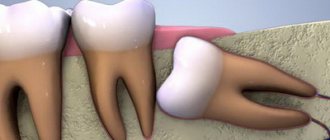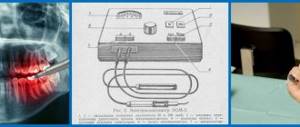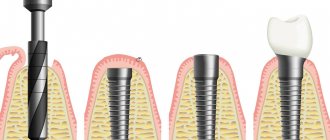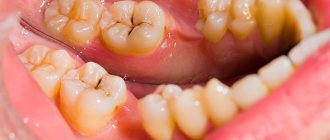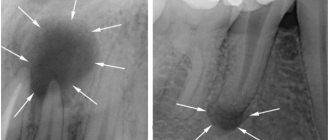Treatment methods for dental cysts
Some experts claim that they can treat a dental cyst without removal - simply by pumping out the purulent fluid from the cavity of the tumor. In some clinics, they can charge up to 30,000 rubles for the procedure, while presenting this manipulation as the “latest technique.”
However, you should not believe empty promises! Six months later, pus and inflammation appear again. Thus, it turns out that the patient is again and again forced to pay a lot of money for a dubious treatment, who receive regular income from this; it is not profitable to cure a person, but it is profitable to treat him endlessly.
Meanwhile, in order to get rid of a dental cyst once and for all, it is necessary, firstly, to properly treat the dental canals, and secondly, to remove all infected tissue, and not just pump out the pus. At the same time, only in the most extreme cases is tooth extraction required! Today, specialists are able to treat a complex multi-channel tooth in just three visits. Only after endodontic treatment, which is necessarily carried out under a microscope, is the patient at the disposal of the surgeon. And this whole set of measures, which will rid you of the problem once and for all, costs significantly less than one-time dubious procedures.
Indications and contraindications
Laser treatment of cysts is effective in removing small tumors. It will allow for high-quality therapy of the pathological process without performing a gum incision or other surgical procedures. However, the technique has a number of contraindications; it cannot be used in the following circumstances:
- Diagnosed obstruction of the dental canals;
- Localization of the cyst in the periodontal pocket;
- Destruction of the crown part of the tooth by more than 60%.
Note that all of the listed contraindications are restrictions on the use of other methods of treating cysts. If they are detected, the tooth must be removed.
Treatment of dental cyst without removal
It is not possible to carry out tooth-preserving cyst removal in only one situation - if we are talking about a formation that has formed on the surface of a wisdom tooth. Such complex cases are quite rare and are accompanied by severe pain. Here, removal of a cyst on a tooth is carried out in a radical manner. In other cases, tooth-preserving techniques are used - this is an immutable rule. Therefore, before you go to a doctor who suggests pulling out a tooth with a cyst, think a hundred times. Perhaps this is simply profitable and convenient, since implantation can then be offered. Installing an implant is the best method for restoring lost teeth, but throughout the world, tooth-preserving principles are paramount in dental treatment. If a doctor can save a tooth, it is his medical duty to do so.
Stages of formation of a dental cyst
Why is a cyst dangerous?
- Flux.
- Purulent inflammation (abscess).
- Sepsis.
- Loss of teeth.
- Inflammation of the lymph nodes.
- Osteomyelitis.
- Chronic sinusitis.
- Various types of tumors.
Due to the complications that have been listed, we can conclude that any pathology causes some harm to the body. Some species can threaten the patient's life. The cyst first destroys one tooth, then gradually spreads to the next ones. Instead of thinking about the need to remove the cyst, you need to urgently contact a specialist.
Surgery to remove a dental cyst
There are three ways to remove a cyst: cystotomy, hemisection and cystectomy.
Cystotomy
Cystotomy is used for large cysts. The doctor removes only those parts of the formation that do not come into contact with the vessels, after which he installs an obturator - a device that prevents tissue fusion - into the resulting cavity. After some time, the remaining portion of the cyst connects with the epithelium of the oral cavity, changes its structure and ceases to be dangerous to the body.
Hemisection
Removal of a tooth root cyst is carried out through hemisection. During the operation, the formation, one of the roots and the adjacent coronal part are removed. The resulting space is restored with an orthopedic design. However, the above method is quite traumatic, so it is considered outdated.
Cystectomies
The operation to remove a dental cyst is performed using the most modern technique - cystectomy. The method allows you to remove the tumor once and for all without affecting healthy dental tissue. The operation to remove a dental cyst takes place under local anesthesia in a surgical office and involves the use of a microscope. First, the specialist determines where exactly the patient’s tumor is located, “opens” it, cleans out the contents with special tools, leaves an antiseptic inside and stitches it up. After some time, the cavity remaining after the operation heals on its own, which does not require additional replanting of bone blocks. A cystectomy takes from 15 to 40 minutes, depending on the size of the cyst and bone structure. An hour after the operation, the patient can go home.
Local anesthesia
Local anesthesia is used for both simple and more complex procedures. An injection is given in the gum area. Usually half of the face is also numbed.
All drugs used for anesthesia must undergo proper monitoring. This type of anesthesia is also used for dental treatment in children and pregnant women.
In most cases, the anesthesia will remain in effect for some time after the end of the operation, and part of the face will remain motionless. It will take time for the nerve endings to return to normal, so the extra hours without pain will be beneficial.
If local anesthesia cannot be used for some reason, treatment under anesthesia is resorted to.
Severe pain after removal and surgeon error -
When a tooth has been removed, the gums hurt so much that even strong analgesics help little - the reason most often turns out to be the incompetence of the surgeon. Unfortunately, many surgeons do not strive to minimize trauma to bone tissue and gums during the removal process, which leads to severe pain. Below we list the main medical “flaws” in the process of tooth extraction -
- When cutting out bone with a drill - according to the rules, when cutting out bone around a tooth, the doctor must use a surgical handpiece that supplies coolant to the drilling area.
In 90% of cases, handpieces without such cooling are used in surgical rooms (24stoma.ru). As a result, the bone suffers a thermal burn and superficial necrosis, and the patient suffers acute pain after removal. If you have had a bone cut out and your gums hurt after tooth extraction: what to do in such a situation will depend on the condition of the socket of the extracted tooth. If the clot is dense and there are no symptoms of inflammation other than pain, you should wait and take strong NSAID-based analgesics. If the socket is empty and there are signs of inflammation (see below), you need to go for a second visit to the dentist and clean the socket.
- Sharp edges of the bone stick out from the socket (Fig. 4-5) - if the bone walls have sharp edges after tooth extraction, then they can injure and break through the mucous membrane (Fig. 4), and even stick out from under it. Or if the interradicular bone septum of multi-rooted teeth has a large height, then it may not be completely covered by a blood clot, protruding from under it.
The origin of this problem is that the doctor either did not bite down the sharp edges of the bone and the high interradicular septum with forceps, or did not apply sutures to the too mobile gum around the tooth in order to bring the edges of the wound closer together. The presence of exposed bone fragments can be determined by the characteristic pain when touching such fragments with the tongue, as well as the occurrence of acute pain in response to cold/hot water. Sometimes they can be seen with the naked eye in the mirror.
- Moving bone fragments in the wound - the surgeon can leave large, inactive bone fragments in the socket of the extracted tooth, which are formed when the tooth dislocates/rocks. Their presence can lead to severe pain and inflammation of the extracted tooth socket, as well as the need for a second visit to the surgeon to remove them.
- An incorrect removal strategy is the most common mistake. The fact is that different doctors (due to differences in experience and intelligence) remove exactly the same teeth in different ways. This leads to the fact that one surgeon can torment the patient for 1-2 hours, trying to use only forceps and elevators when removing and regardless of the trauma caused to the bone, while another will decide to immediately saw the tooth into 2 parts (removing them separately), and spending only 15-25 minutes on the entire removal.
- “Empty hole” (Fig. 6) –
if the doctor used too much anesthetic with a vasoconstrictor (this component promotes vasospasm at the site of anesthesia), then the hole after removal may not fill with blood. Doctors usually don't test for this, but simply apply a tampon and send the patient home. In an empty socket, the bone tissue will be exposed and will react with severe pain.
- The doctor did not put sutures - before removal, the mucous membrane around the tooth is peeled off from it with a trowel, which leads to the fact that the edges of the mucous membrane around the socket of the extracted tooth will be mobile.
Often, even seeing the need for suturing, surgeons are too lazy to do it. Ideally, at least 1 suture should be applied even after the removal of small single-rooted teeth, not to mention multi-rooted ones. Studies have shown that suturing the socket can reduce the intensity of pain by 30-50%, reduce the risk of developing inflammatory complications by up to 90%, accelerate wound healing, and almost completely prevent the loss of a blood clot from the socket and the risk of bleeding. I can recommend to you - always, before removal, ask the doctor to suture the hole (even if you have to pay an extra 250-500 rubles for 1 or 2 stitches). This will save you a lot of nerves. - If the doctor does not prescribe antibiotics after a complex removal, there is a high risk of developing inflammation of the socket and, as a result, severe pain. Antibiotics should only be prescribed by a doctor, so you should go for a re-examination and complain about pain.
What to do in all these situations -
How long does the gum hurt after tooth extraction in these situations - normally, pain should last no more than 1-2 days after simple removal, and its severity should be mild or moderate. Moreover, pain, swelling (if it also appears) and other negative symptoms should gradually decrease. After complex removal, pain can be severe and normally last 3-5 days, but starting from the next day they will also begin to decrease.
If the intensity of the pain does not decrease within 2 days, if you feel bone fragments in the wound with your tongue, if you experience pain in the socket when responding to cold/hot water, if a blood clot has fallen out of the socket, if there is an unpleasant odor from the socket... – you need to urgently go to the surgeon for a second appointment (without waiting for your gums to become inflamed after tooth extraction).
Important: in some cases, pain can also be caused by the patient’s mistakes in how he cares for the socket of the extracted tooth. For example, very often patients begin to rinse their mouth intensively, believing that this will be better. But this leads to the blood clot falling out of the socket and causing severe pain. Read about what you can and cannot do after removal in our article: → “Memo for the patient on how to behave after removal”


